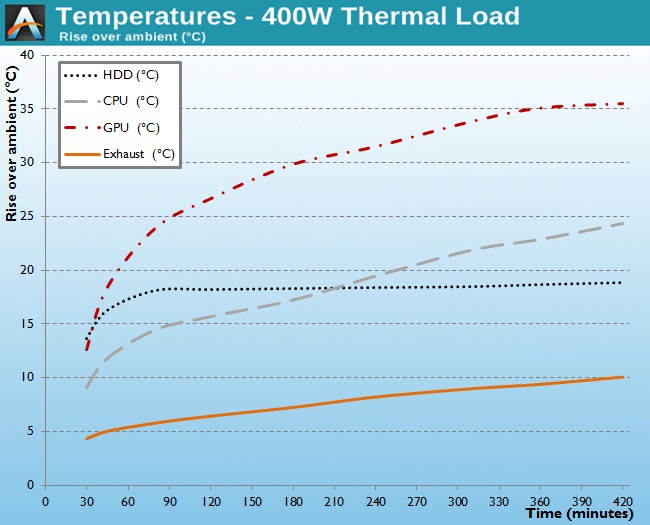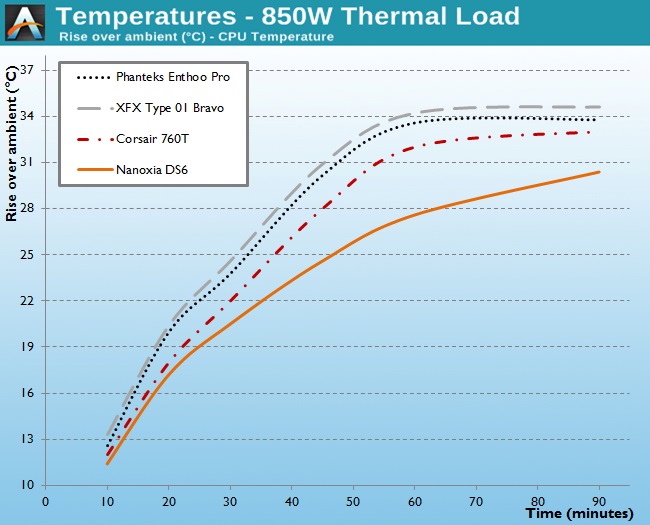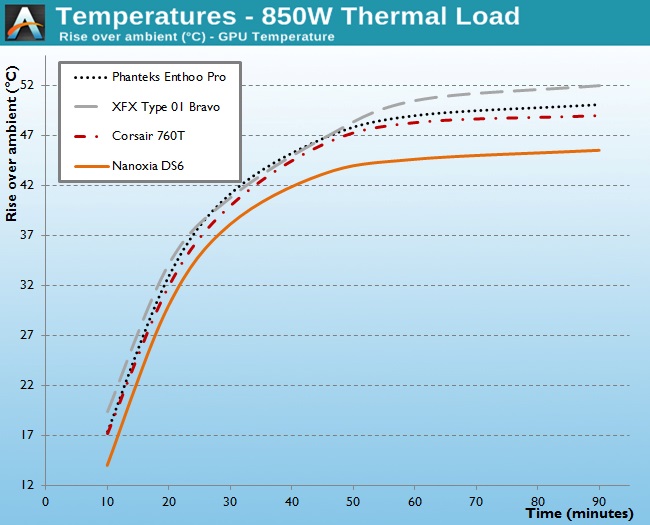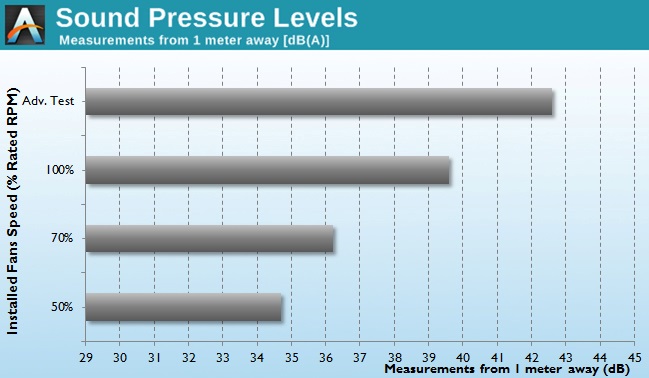The Phanteks Enthoo Pro Case Review
by E. Fylladitakis on March 30, 2015 8:00 AM EST- Posted in
- Cases/Cooling/PSUs
- Full-Tower
- Case
- Phanteks
Test setup
Professional testing requires the emulation of real-world situations but with repeatable results; thus, a perfectly controllable test setup and environment are required, especially for comparable results. Testing the thermal performance of any case with a typical real-world setup technically limits the comparability of the results to this setup alone, as an active system interacts with its environment and the change of a single component would alter myriads of variables. As such, we developed synthetic loads that emulate the thermal output of real systems, which however are passive, steady and quantifiable. As such, the thermal testing now displays the thermal capabilities of the case alone, as if it would have to deal with the entire thermal load by itself, regardless of the system that would be installed inside it. Laboratory data loggers are being used to monitor the PT100 sensors and control the safety relays, which are fully accessible via our custom software. Three such loads have been developed; the ATX version simulates a 200 W CPU, 50 W VRM, 30 W RAM and 4 × 120 W GFX card thermal load. Finally, three 3.5" HDD dummy loads have also been created, with each of them converting 30 W of electrical power to thermal, bringing the total thermal load of the ATX test setup up to 850 Watts. As such, the thermal load is immense and only the best of cases will be able to handle it for more than a few minutes, we are also performing a test with a thermal load of 400W, with all of the aforementioned components except the HDD drives at about 42% power, which is more suitable for the majority of cases.
Thermal testing has been performed with the stock fans operating at maximum speed. Noise testing has been performed with a background noise level of 30.4dB(A). Advanced noise testing is also being performed, in order to assess the ability of the case to dampen the noise of the components installed inside it. This includes the installation of two noise-generating sources (strong fans) inside the case, one positioned approximately over the first expansion slot and one over the CPU area, which generate ≈ 44.2 dB(A) when unobstructed. During the advanced noise test, all stock cooling options of the case are entirely disabled.
Results and discussion
Even though the stock thermal performance of the Enthoo Pro is not going to set any performance records, Phanteks' design can compare with other cases of similar size that are aimed at the same group of consumers. It outperforms the similarly priced XFX Bravo Type-01 and it falls a little behind the Corsair Graphite 760T, which however is currently retailing for nearly twice the price of the Enthoo Pro. The thermal performance of the Enthoo Pro is almost identical with that of the Corsair Obsidian 450D, a more expensive and considerably smaller case.
The stock cooling fans are meant to compromise between thermal performance and comfortable acoustics, meaning that they are neither too strong nor entirely silent, yet they manage to keep the temperatures within acceptable levels without generating too much noise. They are audible at their maximum speed but the noise level is borderline comfortable for home users. Their noise levels drop significantly at lower speeds, making them nearly inaudible at 50% speed. With the PWM fan controller present in the Enthoo Pro, these fans should maintain negligible noise levels while the system is performing casual everyday tasks and turn audible only when the processor load increases significantly, such as during gaming.
The Enthoo Pro is a case that has been designed for cooling performance. With so many openings, its capability to reduce the noise generated by components inside the case is very limited. It managed to reduce the noise coming from our artificial noise source by 1.6db(A), a measurable figure but nevertheless this change is imperceptible by ear - the vast majority of humans can differentiate between noise sources only if there is a change of at least 2.5dB(A) (most require a change of at least 5dB(A) to notice the difference).















50 Comments
View All Comments
mr_tawan - Monday, March 30, 2015 - link
This case has a (Samsung-designed) home button on the top :-).Babar Javied - Monday, March 30, 2015 - link
I really wish more cases would loss the 5.25 inch bays. Not only can you then add larger radiators but they will not interrupt the sleek design.Zak - Monday, March 30, 2015 - link
Not just that. I want more cases that completely ditch anything beyond 2.5" bays for SSDs.I know there are few like that but I happen not to like the designs overall.Samus - Monday, March 30, 2015 - link
Say hello to the ancient FT03-mini, ahead of its time in many ways.Impulses - Monday, March 30, 2015 - link
Or the Corsair Air 540, tho you could argue there could be a second 2.5" cage in the mostly empty right hand compartment (cause who doesn't want 8 or 10 SSD!). The current Silverstone Raven would've been brilliant if they just top mounted a single 5.25" bay instead of an oddball sideways laptop slot drive.Gigaplex - Monday, March 30, 2015 - link
Having a ton of SSDs in a single case is very niche. It's not cost effective and SATA based SSDs are going to be superseded by PCIe very soon.Samus - Tuesday, March 31, 2015 - link
But 2TB laptop 2.5" drives are pretty cheap (not as cheap as 3.5" but still relatively cheap) so unless you need a lot of space (in which case, NAS?) a pair of 2.5" bays made out of one 3.5" bay works quite well for an SSD+HDD. With most high end boards equipped with M2 now, only a single bay is necessary on higher-end builds. I think the days of people putting a bunch of drives in their case is nearing an end. Definitely niche. But at the same time, for some reason, so is ITX. And it shouldn't be. ITX is perfect for 90%+ computer users, most of which will likely never even use the PCIe slot (basic home and office PC's)Jorgisven - Tuesday, March 31, 2015 - link
NAS doesn't work as well with the gaming community. If you've got a slow connection, downloading those 40GB games (that you have a dozen or two of, plus 30-50 other smaller games) is a process you only want to do once. While it's theoretically possible to do with a NAS, it gets really complicated in a multi-computer network that shares a steam library via library sharing. Niche, to be sure, but not unreasonable.Haravikk - Wednesday, April 1, 2015 - link
How many of those games need to be installed at once? A 1tb 2.5" HDD costs what… £40? Or £65 if you opt for the slightly faster SSHD, that's enough for 20-25 games at 40gb each. I can't imagine anyone really needs all of those installed at once, and with digital downloads you can just clear some space and download a title overnight ready to play the next day, if your connection is too slow to handle that, then why is that the case?There are also 2tb drives coming soon, and if you still have to you could stripe two 2.5" disks together for extra capacity (and performance) and just use the NAS for backup.
NLD - Wednesday, September 16, 2015 - link
Get an imagination, I have over 100 installed....But I do have 12 TB of storage...
Before you ask I'm a video editor and store GB of data in edit, 12TB is a puppy to me....